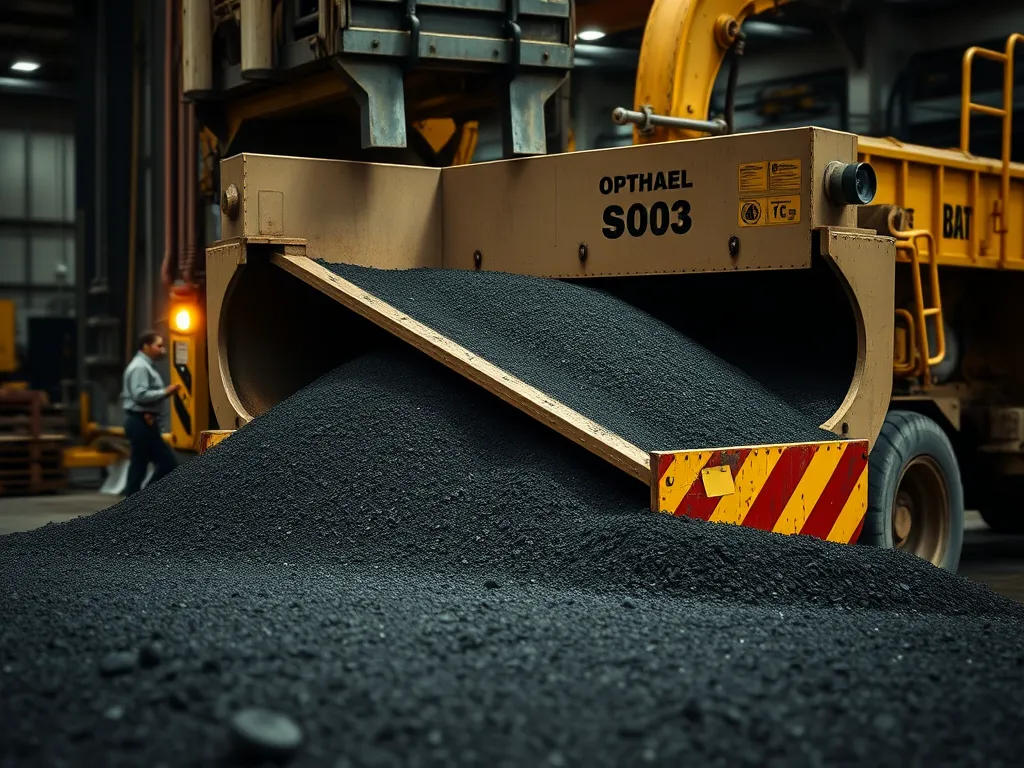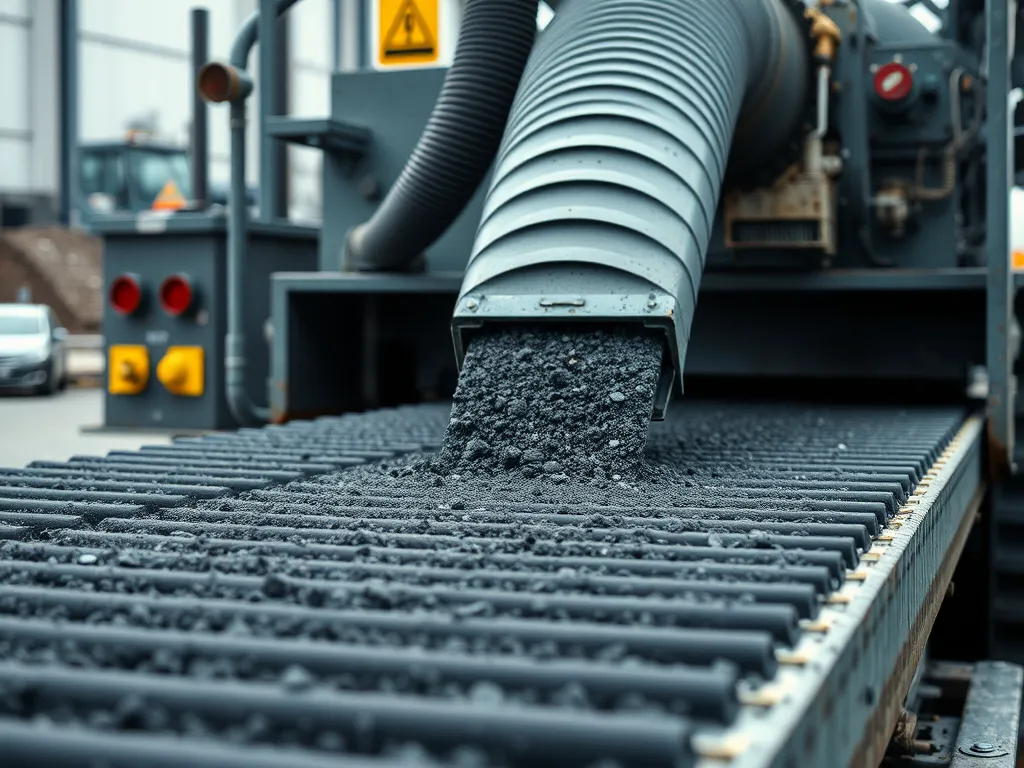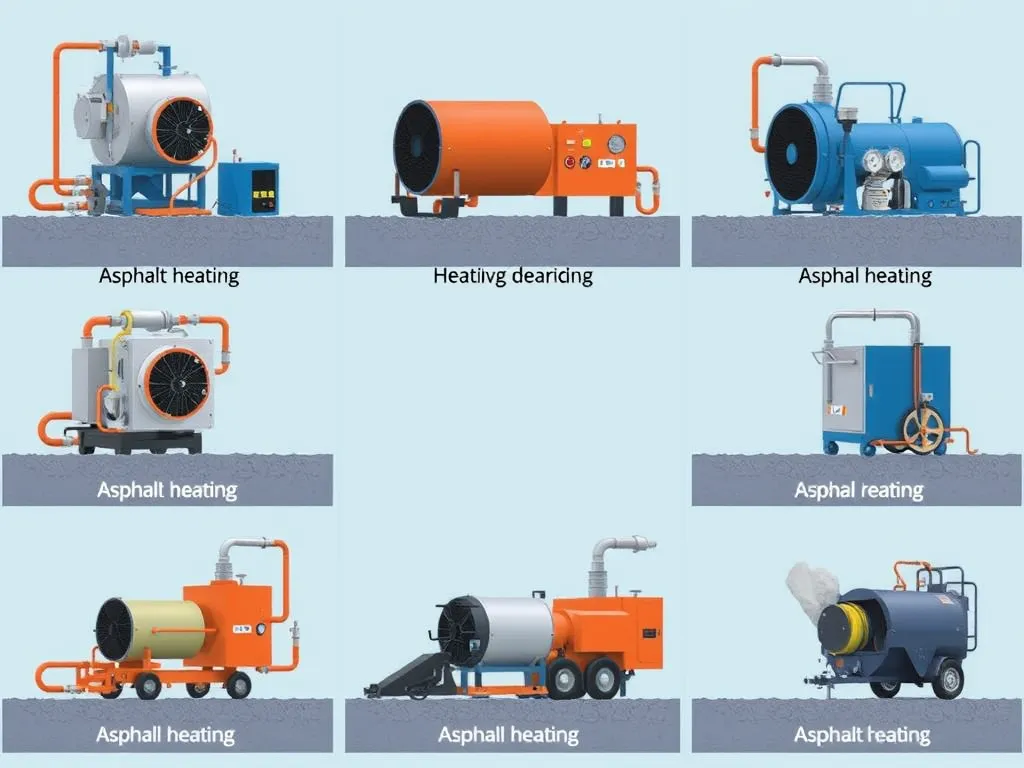Best Practices for Loading Asphalt in a Paver Machine: Start Strong
Published on: September 2, 2025 | Last Updated: April 14, 2025
Written By: George Voss
Properly loading asphalt into a paver machine means positioning delivery trucks correctly, controlling material flow, and maintaining mix temperatures between 275°F and 300°F for Hot Mix Asphalt (HMA). This ensures smooth paving operations, reduces waste by up to 12%, and prevents premature cooling that causes cracks. Key steps include aligning truck beds with hoppers, avoiding pile-ups, and checking screed plates before each load.
This guide shows how to load asphalt efficiently while meeting ASTM D3515 standards. You’ll learn equipment checks, truck coordination tips, and temperature management for both HMA and Warm Mix Asphalt (WMA). We’ll cover troubleshooting hopper blockages, minimizing spillage, and maintaining spindle lift systems. Follow these methods to boost paver efficiency and extend pavement lifespan by 3-5 years.
Contents
Introduction to Asphalt Paver Loading
Loading asphalt into a paver machine sets the stage for every road project. This step determines how smoothly material flows from hopper to screed. Even minor errors here ripple through the entire paving operation.
Importance Of Proper Loading Techniques
Correct loader placement for paver ensures minimal aggregate separation. Dump trucks must align precisely with the hopper to prevent spillage. Operators maintain mix integrity by keeping HMA temperatures between 275-300°F during transfer. Cold spots or temperature drops below 250°F create stiff patches that clog augers.
Proper asphalt paver loading methods also reduce wear on conveyor systems. Overloading the hopper strains feeder mechanisms, while underloading forces frequent stops. Both scenarios increase fuel use by 8-12% and risk thermal cracking in the final mat.
Impact on Paving Quality and Efficiency
Consistent material flow during the asphalt paver loading process directly affects pavement density. Studies show uneven loading causes 15% variations in screed pressure, leading to thickness deviations over 1/4 inch. These flaws shorten road lifespan by 3-5 years.
Efficiency takes a hit when trucks position more than 2 feet from the paver. Each minute spent repositioning costs $45 in labor and equipment downtime. Optimal practices keep cycle times under 90 seconds per truckload, paving 300-400 tons daily.
Next, we’ll break down the exact steps to prepare equipment and crews before loading begins. Master these fundamentals, and your team will lay smoother roads faster.
Pre-loading Prep
Set your paver up for success. Check gear, plan safe steps, and prep the base. These steps keep loads smooth and cuts job site risks.
Gear Check and Tune-up
Test all parts before asphalt hits the hopper. Fix flaws early to stop work halts.
Paver Machine Readiness Checks
- Check engine oil levels and hydraulics – aim for 180-220 psi pressure
- Test conveyor belts – no cracks or frayed edges
- Set auger speed to match mix type – 12-18 RPM for most jobs
Hopper and Screed Plate Care
- Clear hopper walls of old mix – use diesel for tar build-up
- Check screed heat – keep at 250°F to prevent sticking
- Grease slide plates – apply NLGI #2 grease every 4 hours
Safe Material Moves
Guard your crew and gear. Wear thick gloves, steel toes, and eye shields. Use hand signs or radios to guide truck drivers. Block zones where loaders turn. Keep fire kits near hot zones.
Base Setup Rules
A strong base stops cracks and dips. Roll the base layer until it’s flat – no bumps over 1/4 inch. Dampen dry spots to control dust.
What Goes Under Asphalt?
- Crushed stone (3/4” grade) – packs tight, drains well
- Geo-grid fabric – adds strength for high-traffic zones
- Prime coat – use MC-30 oil at 0.12 gal/sq yd rate
With gear prepped and base set, shift focus to nailing the load-in steps. Master truck-paver sync for zero waste.

Step-by-step Loading Process
Efficient asphalt paver loading combines precise equipment positioning with controlled material flow. Let’s break down the sequence.
Positioning the Delivery Truck
Loader placement for paver operations starts with truck alignment. Mispositioned trucks cause delays, uneven material transfer, or safety risks.
Optimal Distance Between Truck and Paver
Maintain 3–5 feet between the truck’s tailgate and paver hopper. This gap allows smooth material transfer while preventing collision risks. For tracked pavers, reduce distance to 2–3 feet to account for machine movement.
Aligning Truck Bed with Paver Hopper
Keep truck bed height 6–8 inches below the hopper’s upper edge. Use hydraulic lifts to tilt beds at 45°–50° angles for gravity-fed flow. Check wheel chocks and parking brakes before engagement.
Controlling Loading Speed and Volume
Asphalt paver loading techniques require balancing speed with hopper capacity. Aim for 25–30 tons of hot mix asphalt (HMA) per hour.
Avoiding Material Pile-Up in the Hopper
Limit truck dump rates to 4–6 tons per minute. Excess buildup causes aggregate segregation. Use hopper paddles to spread material evenly – piles shouldn’t exceed 18 inches in height.
Hopper Management During Loading
Keep at least ⅓ of the hopper full during transitions between trucks. This buffer prevents temperature drops in the HMA.
Maintaining Float Position for Consistent Flow
Engage the paver’s float mode during loading. This setting keeps the screed plate stable, maintaining 290–320°F mix temperatures. Monitor conveyor chain speeds – 12–18 feet per minute prevents dragline formation.
Proper material flow sets the stage for temperature management – a critical factor we’ll explore next.
Also See: Asphalt in Construction Weatherproofing: Project Safety
Material Temperature and Consistency
Proper asphalt temperature during loading ensures smooth material flow and prevents premature cooling. Both Hot Mix Asphalt (HMA) and Warm Mix Asphalt (WMA) require precise thermal management to avoid segregation or mat defects.
Monitoring Hot Mix Asphalt (HMA) Temperatures
HMA must reach 280°F to 325°F at loading for optimal compaction. Use infrared thermometers to check temperatures every 15-20 minutes. Below 275°F, binder viscosity drops, causing uneven spread. Above 330°F, accelerated binder aging risks surface cracks. For PG 64-22 binders (common in northern climates), maintain 290-305°F at the paver hopper.
Handling Warm Mix Asphalt (WMA) Variations
WMA loads at 212°F to 248°F due to additives like zeolites or Sasobit wax. Though energy-efficient (cuts emissions by 20-35%), its lower heat demands tighter coordination. Track thermal retention with handheld thermal cameras. Adjust paver speed to 8-12 feet per minute for WMA’s faster cooling rate. Keep hopper gates 75% open to prevent material bridging.
Temperature management directly impacts screed performance and joint durability. Next, we’ll review post-loading checks to catch issues before compaction begins.

Post-loading Checks
Once asphalt loads hit the paver, checks keep work smooth. These steps stop flaws before paving starts.
Inspecting for Material Build-up
Check hopper walls and chains post-load. Built-up mix cools fast, forms clumps. Use scrapers to clear stuck bits. Left chunks block flow, cause uneven mats. Aim for zero residue in feed zones.
Verifying Screed Plate Cleanliness
Wipe screed plates after each load. Sticky bits on edges tear new asphalt. Heat plates to 275°F min to stop mix from clinging. A clean screed lays flat mats with tight joints.
Assessing Spindle Lifting Mechanisms
Test spindles that lift the screed. Move them up/down 3 times. Look for slow shifts or jerks. Grease joints if noise hits 85 decibels. Smooth spindles keep pave depth within 1/8″ specs.
Solid checks set up the next phase: fine-tuning how you move mix from truck to road. Dialed-in steps cut waste and boost speed.
Optimizing Loading Efficiency
Mastering asphalt paver loading techniques cuts project timelines by up to 18% while maintaining surface density above 96%. Three strategies separate adequate work from peak performance.
Minimizing Downtime Between Truckloads
Schedule trucks to arrive 30 seconds before hopper depletion. Track material usage rates—a 10-foot-wide lane at 1.5-inch thickness requires 125 tons per mile. Use telematics systems to monitor paver speed against truck intervals. Keep mix temperatures above 275°F during transfers to prevent premature cooling. Stagger truck approach times to maintain continuous material flow.
Coordinating With Delivery Trucks
Establish clear protocols using two-way radios or GPS-linked dispatch software. Position trucks at 45-degree angles during reverse approaches for safer alignment. Maintain 18-24 inches between truck tailgates and paver push rollers. For projects requiring 100+ tons/hour, deploy 7-8 trucks rotating in sequence. Train drivers to match paver speeds between 10-20 feet per minute during material transfer.
Balancing Hopper Capacity and Paving Speed
Keep hoppers ⅔ full—overfilling causes aggregate segregation, while underfilling risks mat tears. Match auger speed to material demand: 12-15 RPM for standard 9.5mm mixes. Adjust slat conveyors to maintain 6-inch material depth across the screed. Monitor temperature differentials—surface mats cooling 25°F faster than hopper-stored material need adjusted laydown rates.
These asphalt paver loading methods set the stage for addressing environmental impacts—efficient operations directly reduce fuel use and emissions during material transfers.

Environmental Considerations
Proper asphalt paver loading methods reduce harm to the environment. Smart material handling cuts waste. It also limits harmful fumes and dust.
Reducing Material Waste During Loading
Plan loads to match paver speed. Keep hoppers 1/3 to 1/2 full. This avoids spillage from overfill. Use recycled asphalt pavement (RAP) when possible. RAP mixes save 20-30% new binder. Check mix temps with infrared guns. Keep hot mix asphalt (HMA) between 275°F and 300°F. Cold mix clogs hoppers, forcing dump trips. Train crews in proper loading asphalt into paver machine steps. Track waste per ton laid. Aim for under 2% loss.
Managing Spillage and Emissions
Fit trucks with belly dump trailers. They drop mix straight into hoppers. Less spill than end-dump trucks. Place tarps under paver joints. Catch stray bits for reuse. For fumes, switch to warm mix asphalt (WMA). WMA pours at 50°F cooler than HMA. Cuts VOC gases by 40%. Run diesel pavers at Tier 4 emission levels. Add mist sprays to hoppers. They trap PM2.5 dust during loading. Seal gaps on augers with rubber flaps. Stops mix leaks onto the base.
These steps not only protect the site but also set up the crew to tackle operational challenges effectively.
Troubleshooting Common Issues
Even with strict adherence to asphalt paver loading best practices, unexpected challenges can disrupt operations. Let’s break down fixes for three frequent problems.
Addressing Mix Temperature Drops
Hot mix asphalt (HMA) loses 5-10°F per minute when exposed. If material temps fall below 275°F during loading, expect poor compaction. Check PG binder grades – PG 64-22 requires 290-320°F laydown temps. Use thermal blankets on trucks, shorten haul distances, or switch to warm mix asphalt (WMA) with additives like Evotherm to extend workability.
| Issue | Solution | Temp Threshold |
|---|---|---|
| Cooling at hopper edges | Reduce batch plant discharge time | 25°F drop max |
| Surface tearing during spread | Increase screed heat to 250°F | Mat temp ≥225°F |
Resolving Hopper Blockages
Material jams often stem from segregated mix or oversized aggregates exceeding 1/2 inch. Keep the paver’s slat conveyor speed 10-15% faster than truck unloading rates. For sticky mixes, apply liquid release agents (soap/water blends at 4:1 ratio) to hopper walls. If blockages persist, inspect auger flighting gaps – they should match aggregate size specifications.
Managing Delays in Material Delivery
When truck gaps exceed 8 minutes, paver stops create cold joints. Maintain two trucks on standby during peak paving. For extended delays (15+ minutes), set the screed lift and cut back 6 inches before restarting. Use remixing transfer vehicles like Roadtec Shuttle Buggy® to reheat stored material, retaining temps up to 275°F for 30 minutes.
These fixes keep your paver machine asphalt loading techniques efficient. Next, let’s tackle frequent questions about screed mechanics and roller patterns.

Frequently Asked Questions
What Are the Types Of Asphalt Mixes Used in Paving?
There are several types of asphalt mixes, including Hot Mix Asphalt (HMA), Warm Mix Asphalt (WMA), and Cold Mix Asphalt. HMA is used for high traffic areas, while WMA allows for lower temperatures during mixing and is more environmentally friendly. Cold Mix is typically used for patching in cooler conditions.
What Preparation is Needed Before Loading Asphalt?
Before loading asphalt, it’s essential to perform equipment inspections, calibrate settings, and ensure that the paver machine is ready. This includes checking the hopper and screed plate for cleanliness and functionality, as well as preparing the base layer properly.
What Should Be Monitored When Loading Asphalt?
While loading asphalt, it’s crucial to monitor the temperature of the mix, the flow within the hopper, and the alignment of the delivery truck with the paver machine. This helps prevent temperature drops and ensures a smooth and efficient loading process.
What is the Ideal Temperature for Asphalt During Loading?
The ideal temperature for Hot Mix Asphalt (HMA) during loading is typically between 280°F and 325°F. For Warm Mix Asphalt (WMA), the temperature should be between 212°F and 248°F. Maintaining these temperatures is key to ensuring proper compaction and avoiding mat defects.
How Do You Ensure Safe Loading Practices?
To ensure safe loading, implement clear communication protocols among crew members and truck drivers, use appropriate personal protective equipment, and maintain a well-organized loading area. Following safety guidelines while handling materials is crucial to prevent accidents and injuries.
What Are the Consequences Of Poor Loading Techniques?
Poor loading techniques can lead to numerous issues, including uneven asphalt mats, increased wear and tear on equipment, and unnecessary fuel costs. Additionally, improper loading can create cold spots in the asphalt, resulting in premature cracking and lower pavement lifespan.
How Can Technology Assist in the Loading Process?
Technology, such as telematics systems, can enhance the loading process by tracking paver speeds, coordinating truck schedules, and monitoring material temperatures. This data-driven approach allows for more efficient and effective asphalt loading operations.
What Maintenance is Required for Paver Machines?
Regular maintenance for paver machines includes checking oil levels, inspecting hydraulic systems, cleaning hopper walls, and ensuring the screed plate is functioning correctly. Consistent maintenance prevents breakdowns and enhances the machine’s performance during loading and paving operations.
Closing Thoughts
Loading asphalt into a paver machine is more than just transferring material; it requires precision and attention to detail. By following best practices, you ensure optimal paving quality, efficiency, and safety. Remember to conduct thorough pre-loading preparations, monitor temperatures, and manage post-loading inspections effectively.
From positioning the delivery truck correctly to keeping a close eye on hopper management, each step enhances the overall outcome. Additionally, addressing common issues like temperature drops and hopper blockages swiftly helps maintain workflow continuity. Lastly, incorporating environmental considerations can bolster your project’s sustainability.
For more insights and resources on asphalt loading techniques, check out Asphalt Calculator USA.
Additional Resources for You:
- Yoder, E. J., & Witczak, M. W. (1975). Principles of Pavement Design (2nd ed.). New York, NY: Wiley.
- How Does an Asphalt Paver Work? – LeeBoy®
- 9 Essential Asphalt Paving Tips That Improve Quality
- | AsphaltPro Magazine | Paving Speed Changes Quality
- r/asphalt on Reddit: Picking a paver machine


